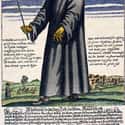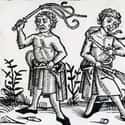-
(#1) The Plague Called For An Entirely New Type Of Doctor
There were several types of doctors in the medieval world. Physicians were individuals who had received some sort of university training, while surgeons lacked a formal education and were therefore considered inferior. Surgeons were often associated with barbers, who were allowed to let blood and pull teeth.
Apothecaries were responsible for dispensing drugs or, during the Middle Ages, herbs, sweets, and perfumes. There were also knowledgeable women – all of the other doctors were men – who were familiar with natural remedies and produced potions, salves, and tonics in their homes.
Then, during the outbreak of the plague, a new type of doctor was developed. There were specific physicians who became known as plague doctors, specializing in preventing and treating the plague. They were hired by villages during the fourteenth century epidemic and throughout the next four centuries whenever the plague would pop back up.
-
(#2) Plague Doctors Started Wearing Those Creepy Outfits Long After The Middle Ages
During the 17th century, plague doctors started wearing uniforms in an effort to protect themselves from their patients. Charles de l’Orme came up with concept of the long, dark robe worn with boots, gloves, and a hat in 1619.
The idea was to keep the physician's entire body covered. The outer layer of the costume was made of goat leather and often coated in wax. Underneath, the doctor wore a blouse that tied to his boots.
-
(#3) Plague Masks Were All About Smelling The Roses
The infamous plague masks were actually associated with air purity. During the 17th and 18th centuries, the idea that the air could be polluted became widespread and doctors sought to prevent "bad air," or the miasma, from getting to them.
Eye holes were fitted with glass pieces so doctors could still see, and the long noses on the mask were filled with drugs and aromatic herbs, including mint, camphor, cloves, straw, laudanum, rose petals, and myrrh to filter the air. The herbs also helped with the smell, considering that the dead bodies and lanced buboes that doctors dealt with were rather pungent.
However, despite rumors, 'Ring Around The Rosie' was most likely not about the plague.
-
(#4) Plague Doctors Used Canes So They Could Be More Hands Off
The canes that plague doctors carried served a few practical purposes. Doctors could use them to poke and prod a patient that was laying on the ground without having to touch them directly, and they may have been used to keep family members at bay or to protect themselves from desperate patients. They could also be used to communicate to their helpers where a body needed to go after a patient died.
-

(#5) Plague Doctors Treated Everyone Because Everyone Got The Plague
Wealth certainly offers greater access to healthcare - that hasn’t changed much - but during the Middle Ages, plague doctors were hired by towns and villages to treat everyone. Since the location was paying them, not the individual, all sick people were provided with the same medical care.
For example, when Giovanni de Ventura served as a community plague doctor in Pavia in 1479, he received a monthly payment, a furnished house, local citizenship, and living expenses from the city. He didn't charge the patients, but could take payment from individuals if they offered.
-

(#6) Common Treatments Were Not Pleasant
Medieval medicine was based around the idea that the human body had four humors that needed to be in balance. Blood, phlegm, yellow bile, and black bile were to be balanced with the help of diet, herbs, natural medicines, and, if things got too far out of whack, blood would be removed from the body entirely. Hence, bloodletting.
In terms of plague treatments, doctors typically stuck with what they knew and tried to remove the toxic imbalance from the body by bloodletting their patients. They also lanced, rubbed toads on, or leeched the buboes to try to remove the sickness.
Sex was prohibited too, but that rarely stuck.
-

(#7) The Treatments Got Worse The Sicker A Person Got
Sometimes patients would be told to drink their own urine or consume medicines made from egg shells, marigolds, and treacle. Patients would also be rubbed with onion, garlic, butter, arsenic, or flower petal compounds, or even be advised to rub animal parts on their body to try to eliminate the illness. Frogs, snakes, and pigeons were particularly popular if they were nearby. Once buboes were lanced, they were then often rubbed with a mixture of tree sap, flower petals, and human excrement.
As a person neared death, they could even be coated in mercury and baked in an oven for a while. There were also techniques to induce diarrhea to try to drive out whatever evil had taken over the body.
-
(#8) Treatments Also Included Making God Happy
During the Middle Ages, the belief was that bad things happened because God was dissatisfied with humanity. This meant that people needed to make amends. As a result, self-flagellation became a common treatment for the plague. Individuals would whip themselves in order to atone for whatever sins had brought about the disease.
In fact, there were entire groups of flagellants dedicated to the practice. But, when a person couldn't whip themselves sufficiently or were already sick and too weak, they often asked the plague doctors to do it for them.
-

(#9) When All Else Failed, People Found Scapegoats
When God throws down a scourge, the tendency is to try to find a reason - and someone to blame. Christians tried to identify Jews as the cause of the disease - although Pope Clement VI issued a statement saying that it wasn't their fault. However, this didn't stop people from looking for a scapegoat.
Pope Clement VI even famously surrounded himself with fire to keep the evil of the plague from infecting him, but it was actually the heat itself that kept him safe, not the fire warding off evil spirits.
-
(#10) Plague Doctor Hats Were Used For Identification
While the plague doctor needed to be protected from head to toe, the hats themselves were actually used to indicate that a person was in fact a doctor. The hats were symbolic than functional, though it's possible that the wide brim did manage to keep some bacteria away.
-
(#11) Plague Doctors Served As Record Keepers and Record Watchers
One of the most beneficial contributions made by plague doctors was the sheer volume of detailed information they kept about their patients. Plague doctors kept registers of the number of victims for public record, documented people's last wishes, and often testified for and witnessed wills being sorted. Their service to the public went beyond just medical care.
-

(#12) They Did Autopsies, Which Were More Common Than You'd Think
The medieval period isn't really known for its medical advancements, but people at this time were often more informed than you'd think. In addition to the wide amount of information available on the plague thanks to Jewish and Arab sources, bodies were often dissected in order to yield forensic and anatomical information. In the 13th century, the Papacy banned the destruction of a body, but what that actually meant is still debated.
Regardless, during the plague, plague doctors were tasked with autopsying bodies to determine the cause of death and try to understand the mysterious illness that was killing so many people so quickly
-

(#13) Plague Doctors Were Probably Pretty Lonely
Plague doctors were necessarily separated from the rest of the population of a town or village where they were tending to patients. This was to protect the doctor as well as the healthy citizens alike. Giovanni de Ventura, according to his contract, was only allowed to move about the city when he was accompanied by an escort, unless he was seeing patients.
After a period of serving as a plague doctor, the physician would then spend at least 40 days in isolation; however, generally speaking, plague doctors lived their lives under quarantine due more to social stigma than anything else.
New Random Displays Display All By Ranking
About This Tool
In the Middle Ages, the Black Death was spread around Europe. In order to prevent infection, plague doctors wore waxed linen or canvas shirts and a beak mask that could filter the air. For the treatment of the Black Death, the most popular treatment at that time was bloodletting. This mysterious medical treatment was the top medical technology, but because the blood was infectious, plague doctors became a high-risk population.
Most of the plague doctors in the Middle Ages in Europe were part-time by clerics. European people fled due to panic and could not effectively control the epidemic. The random tool explained 13 horrifying things about plague doctors.
Our data comes from Ranker, If you want to participate in the ranking of items displayed on this page, please click here.
















